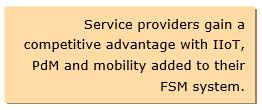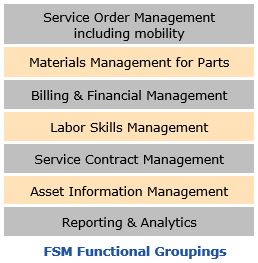Technology adoption has significantly increased the benefit to cost ratio for acquiring a Field Service Management (FSM) systems. This improves the business case for adopting or upgrading an FSM system with lower initial cost and higher benefits. Technologies like mobility, global positioning systems (GPS), digital maps, and analytics enable route optimization which has reduced operating costs and improved customer satisfaction. Meanwhile, using Software as a Service (SaaS) has lowered the initial investment.
IIoT Improves Service Metrics and Competitive Advantage 
For FSM systems, Industrial Internet of Things (IIoT) offers new sources of customer benefit. IIoT combined with analytics offers enhanced condition monitoring and predictive maintenance (PdM). With alerts automatically sent to FSM, this technology increases the value of a modern FSM system. With PdM, service providers become aware of an issue before it cascades into dreaded unplanned downtime and customer complaints. Repair is planned and executed prior to failure. The service provider or OEM can deliver to a higher service level agreement (SLA) and gain a competitive advantage.
Mobile Devices Assure Effective Execution For FSM applications, adoption of mobile devices for work order execution by a technician continues to grow with increased compliance, data quality, and visibility. Route optimization improves labor efficiency and compliance with SLAs. Customer satisfaction improves since the technician has access to information (documentation and IIoT data) that increases the first time fix rate and lowers mean time to failure (MTBF). The end customer sees enhanced uptime, asset longevity, and safety. This further improves a service provider’s competitive advantage.
Key FSM Functions 
Key areas of functionality for FSM applications are segmented here.
Service order management involves the work performed by employees and contractors. This includes the processes, technology, and access to information related to creating, planning, scheduling, executing, documenting, and tracking their activities.
Mobility includes the application functionality needed for those people that are mobile – particularly technicians in the field whose prime focus is the execution of work orders, including access to materials inventory and asset information while the technician is at the asset’s location.
Materials management includes the processes, technology, and in-formation for material procurement and inventory management.
Financial management functions include invoicing clients for the services provided and accepting payment.
Labor management includes the processes and information related to skills assessment, training, and certification of labor resources (including both internal employees and contractor personnel).
Service contract management includes the processes and information related to creating and managing contracts and service agreements for clients.
Asset lifecycle information management (ALIM) encompasses the data and documentation for each physical asset. .
Reporting & Analytics includes functionality for analyzing performance. This supports decision-making in real time - when it is most effective.
For more information on the new EAM market outlook study, go to:
/market-studies/field-service-management

 For FSM systems, Industrial Internet of Things (IIoT) offers new sources of customer benefit. IIoT combined with analytics offers enhanced condition monitoring and predictive maintenance (PdM). With alerts automatically sent to FSM, this technology increases the value of a modern FSM system. With PdM, service providers become aware of an issue before it cascades into dreaded unplanned downtime and customer complaints. Repair is planned and executed prior to failure. The service provider or OEM can deliver to a higher service level agreement (SLA) and gain a competitive advantage.
For FSM systems, Industrial Internet of Things (IIoT) offers new sources of customer benefit. IIoT combined with analytics offers enhanced condition monitoring and predictive maintenance (PdM). With alerts automatically sent to FSM, this technology increases the value of a modern FSM system. With PdM, service providers become aware of an issue before it cascades into dreaded unplanned downtime and customer complaints. Repair is planned and executed prior to failure. The service provider or OEM can deliver to a higher service level agreement (SLA) and gain a competitive advantage.  Key areas of functionality for FSM applications are segmented here.
Key areas of functionality for FSM applications are segmented here. 
